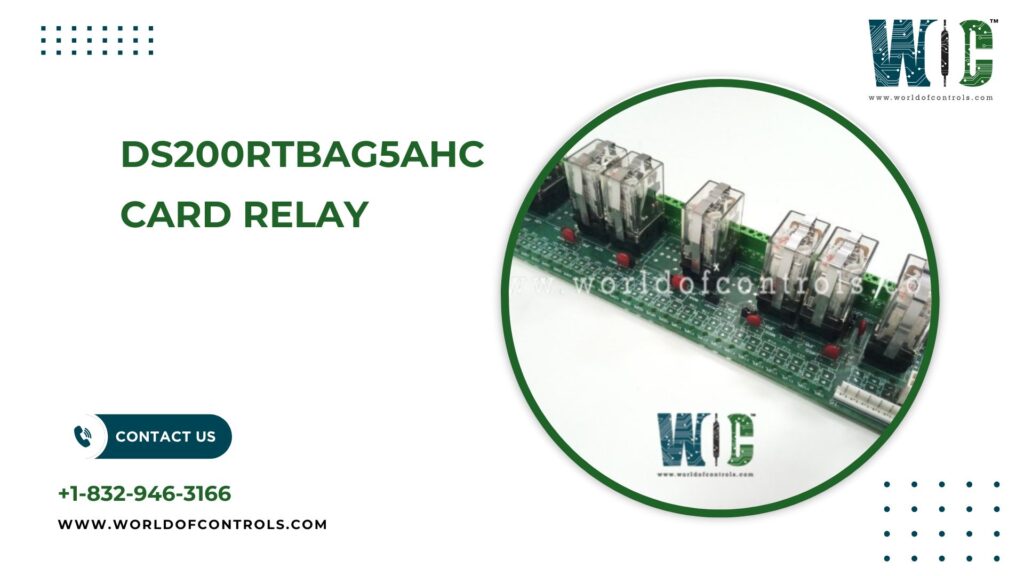
DS200RTBAG5AHC
Introduction
Turbine control systems are the backbone of modern power generation infrastructure, and General Electric’s Mark V system has long been a trusted platform in this domain. Among its many components, relay cards serve a critical function by interfacing between the digital logic of the control system and physical field devices. This article explores the role of relay cards in GE’s Mark V turbine control architecture and explains how they contribute to system safety, reliability, and performance.
What Is a Relay Card?
A relay card, sometimes called a relay terminal board, is an interface module used to control and isolate field devices such as solenoids, alarms, and actuators from the core logic of a control system. These cards are equipped with electromechanical relays that switch electrical circuits in response to control signals, enabling precise and safe execution of commands.
Key Functions:
- Signal switching and amplification
- Electrical isolation between low-voltage logic and high-voltage field devices
- Circuit protection and manual override support
- Integration of external alarms and indicators
Overview of GE Mark V Turbine Control System
The Mark V control system is a robust, microprocessor-based platform designed for controlling gas and steam turbines. It supports both simplex and triple modular redundant (TMR) configurations, allowing high availability and fault tolerance. Its architecture is composed of multiple modules, including processor cards, input/output boards, and interface components like relay cards.
Relay cards in the Mark V play an essential role by:
- Translating logical output signals into physical actions
- Activating or deactivating hardware such as pumps, fans, and valves
- Engaging safety mechanisms during fault conditions
- Supporting alarm and indication circuits for operators
Role of Relay Cards in System Operation
Relay cards are typically housed within the <R>, <S>, or <T> control cores of the Mark V system. They interface with digital output signals from processor boards and use those signals to actuate various electromechanical relays.
Applications in Turbine Control:
- Startup and Shutdown Procedures: Relay cards control auxiliary equipment necessary for safe turbine start and stop sequences.
- Trip Logic: They serve as a critical part of the turbine’s trip system, allowing for immediate shutdown in hazardous scenarios.
- Alarm Signaling: Relay outputs are often wired to status indicators, sirens, or warning systems to alert operators of system anomalies.
- Manual Operations: During maintenance, relay cards allow for manual override of certain outputs, ensuring flexibility and control in non-automated scenarios.
Because the relays physically open or close electrical contacts, these cards are also instrumental in ensuring compliance with safety standards and operational protocols.
Design and Maintenance Considerations
Modern relay cards are designed with modular features to simplify maintenance and reduce downtime. They often include plug-in relays, labeled terminals, and status LEDs for quick identification and diagnostics.
Maintenance Best Practices:
- Regular testing of relay operation and contact integrity
- Inspection for corrosion, wear, or pitting on contacts
- Verification of correct field wiring and grounding
- Use of system diagnostics to monitor relay activity and response time
Relay cards are typically tested as part of scheduled maintenance routines or during system commissioning to verify functionality before turbine operation.
Enhancing Reliability and Safety
The reliability of turbine operations heavily depends on the correct functioning of relay interface modules. These cards act as a bridge between intelligent control systems and mechanical actuators, making them essential to both automation and safety processes. In systems configured with redundancy, relay cards may operate in parallel, ensuring that control signals are executed even if a single card fails.
The physical separation of control and load circuits also minimizes the risk of electrical interference, improving signal integrity and protecting sensitive electronic components from transient voltages or surges.
Conclusion
Relay cards are often overlooked but are absolutely critical in the operation of GE Mark V turbine control systems. They provide the necessary electrical interface between the logic-driven control system and the high-power demands of real-world field devices. By delivering reliable signal switching, electrical isolation, and fault tolerance, relay cards uphold the safety, efficiency, and stability of turbine operations across the globe.
